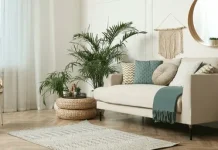When it comes to transforming your home, few things have as much impact as color and light. Together, they can create a mood, enhance a space, and even affect our emotions. In this blog post, we’ll explore the power of color and light in interior design, and share some tips for using them to transform your home.
Table of Contents
The Basics of Color Theory
To understand the impact of color in interior design, it’s important to have a basic understanding of color theory. Color theory is the study of how colors interact with each other, and how they can be used to create different moods and effects.
There are three primary colors: red, blue, and yellow. These colors cannot be created by mixing other colors together. When you mix two primary colors together, you get a secondary color: orange, green, or purple. Tertiary colors are created by mixing a primary color with a secondary color.
Warm colors (red, orange, yellow) are energizing and stimulating. They can create a sense of warmth and intimacy in a space. Cool colors (blue, green, purple) are calming and relaxing. They can create a sense of serenity and peace.
The Impact of Color on Interior Design
Color has a profound impact on how we perceive a space. It can create a mood, emphasize certain features, and even affect our emotions.
In general, lighter colors tend to make a space feel larger and more open, while darker colors can make a space feel smaller and more intimate. However, this isn’t always the case. A small room painted in a dark, rich color can feel cozy and inviting, while a large room painted in a light, cool color can feel spacious and calming.
When choosing colors for your home, consider the mood you want to create. Do you want a space that feels energizing and vibrant, or calm and serene? Do you want to highlight certain features, like a fireplace or a piece of artwork, or create a cohesive look throughout the space?
Using Light to Enhance Your Home
Light is another powerful tool in interior design. It can create a sense of space, highlight certain features, and even affect our mood.
Natural light is the best type of light for any space. It’s free, it’s abundant, and it’s the most flattering. If you’re lucky enough to have a lot of natural light in your home, make the most of it. Choose window treatments that let in as much light as possible, and position furniture to take advantage of the light.
If natural light is limited, or if you want to create a specific mood or effect, you can use artificial light to enhance your space. Here are a few tips:
- Use task lighting to highlight specific areas, like a desk or a reading nook.
- Use accent lighting to highlight artwork or other features.
- Use ambient lighting to create a soft, flattering glow throughout the space.
- Use dimmer switches to adjust the lighting to suit your mood and needs.
Combining Color and Light
When you combine color and light, you can create some truly stunning effects. Here are a few tips for combining color and light in your home:
- Use warm-colored light bulbs to enhance warm colors, and cool-colored light bulbs to enhance cool colors.
- Use lighting to create contrast between light and dark areas of the room.
- Use lighting to create depth and texture in the space.
- Use lighting to draw attention to certain features, like a fireplace or a piece of artwork.
Incorporating Color and Light into Your Home
Now that you understand the power of color and light in interior design, it’s time to start incorporating them into your home. Here are some tips for using color and light to transform your space:
- Choose a color palette: Start by choosing a color palette that reflects your personal style and the mood you want to create. Consider the colors of your furniture, flooring, and other elements in the room, and choose colors that complement or contrast with them. You can use tools like color swatches or online color palettes to help you choose.
- Paint the walls: Painting the walls is one of the most impactful ways to use color in a room. Choose a color that reflects the mood you want to create, and consider painting an accent wall in a contrasting color for added interest. If you’re hesitant to commit to a bold color, start with a neutral shade and add pops of color through accessories and decor.
- Add lighting: Once you have your color palette in place, it’s time to add lighting. Consider the natural light in the room and choose lighting fixtures that complement it. Add task lighting where needed, and use accent lighting to highlight artwork or other features. Don’t forget to use dimmer switches to adjust the lighting to suit your mood.
- Add colorful accessories: Once you have your walls and lighting in place, it’s time to add colorful accessories. Choose accessories in your chosen color palette, and consider using texture and pattern to add interest. Think to throw pillows, area rugs, curtains, and artwork.
- Experiment: Don’t be afraid to experiment with color and light. Try out different combinations and see what works best for your space. You might be surprised by the impact even small changes can make.
In Conclusion
Color and light are two of the most powerful tools in interior design. They can create a mood, enhance a space, and even affect our emotions. When using color and light to transform your home, start by choosing a color palette that reflects your personal style and the mood you want to create.
Paint the walls, add lighting, and incorporate colorful accessories like sculpture stands
or round pedestals. Don’t be afraid to experiment and see what works best for your space. With a little bit of effort, you can transform your home into a space that’s both beautiful and functional.








